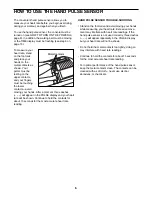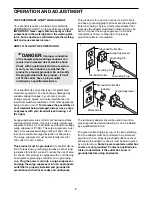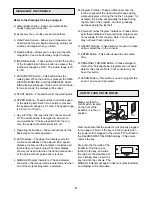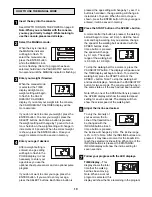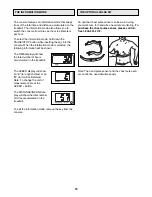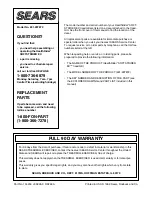
19
The following guidelines will help you to plan your exer-
cise program. For more information about exercise,
consult your physician or obtain a reputable book.
EXERCISE INTENSITY
Whether you want to burn fat or to strengthen your
cardiovascular system, you can tailor your exercise to
your specific goals. The key to achieving the desired
results is to exercise with the proper intensity. As you
exercise, your heart rate should be kept at a level be-
tween 70% and 85% of your maximum possible heart
rate. This is known as your training zone. You can find
your training zone in the table below. Training zones
are listed according to age and physical condition.
To measure your heart rate during your workouts, use
the hand pulse sensor or the optional chest pulse sen-
sor (see page 5).
Burning Fat
To burn fat effectively, you must exercise at a relatively
low intensity level for a sustained period of time. During
the first few minutes of exercise, your body uses easily
accessible
carbohydrate calories
for energy. Only after
the first few minutes of exercise does your body begin
to use stored
fat calories
for energy. If your goal is to
burn fat, keep your heart rate near the low end of your
training zone as you exercise.
Aerobic Exercise
If your goal is to strengthen your cardiovascular sys-
tem, your exercise must be Òaerobic.Ó Aerobic exercise
is activity that requires large amounts of oxygen for
prolonged periods of time. This increases the demand
on the heart to pump blood to the muscles, and on the
lungs to oxygenate the blood. For aerobic exercise,
keep your heart rate near the middle of your training
zone as you exercise.
WORKOUT GUIDELINES
Each workout should include three parts: (1) a warm-
up, (2) training zone exercise, and (3) a cool-down.
Warming Up
ÑBegin each workout with five to ten
minutes of stretching and light exercise to warm up. A
proper warm-up increases your body temperature, heart
rate, and circulation in preparation for exercise.
Training Zone Exercise
ÑAfter warming up, increase
the intensity of your exercise until your heart rate is in
your training zone for 20 to 30 minutes. Breathe regu-
larly and deeply as you
exerciseÑnever hold your breath.
Cooling Down
ÑEnd each workout with five to ten
minutes of stretching to cool down. This will develop
muscle flexibility and will help to prevent post-exercise
problems.
Exercise Frequency
To maintain or improve your condition, complete three
workouts each week, with at least one day of rest be-
tween workouts. After a few months, you may complete
up to five workouts each week if desired. The key to
success is to make exercise a regular and enjoyable
part of your everyday life.
CONDITIONING GUIDELINES
WARNING:
Before beginning
this or any exercise program, consult your
physician. This is especially important for
individuals over the age of 35 or individuals
with pre-existing health problems.
The hand pulse sensor is not a medical de-
vice. Various factors, including the user's
movement, may affect the accuracy of heart
rate readings. The hand pulse sensor is in-
tended only as an exercise aid in determining
heart rate trends in general.
20
138-167
133-162
25
136-166
132-160
30
135-164
130-158
35
134-162
129-156
40
132-161
127-155
45
131-159
125-153
50
129-156
124-150
55
127-155
122-149
60
126-153
121-147
65
125-151
119-145
70
123-150
118-144
75
122-147
117-142
80
120-146
115-140
AGE
Unconditioned
Conditioned
TRAINING ZONE (Beats/Min.)


